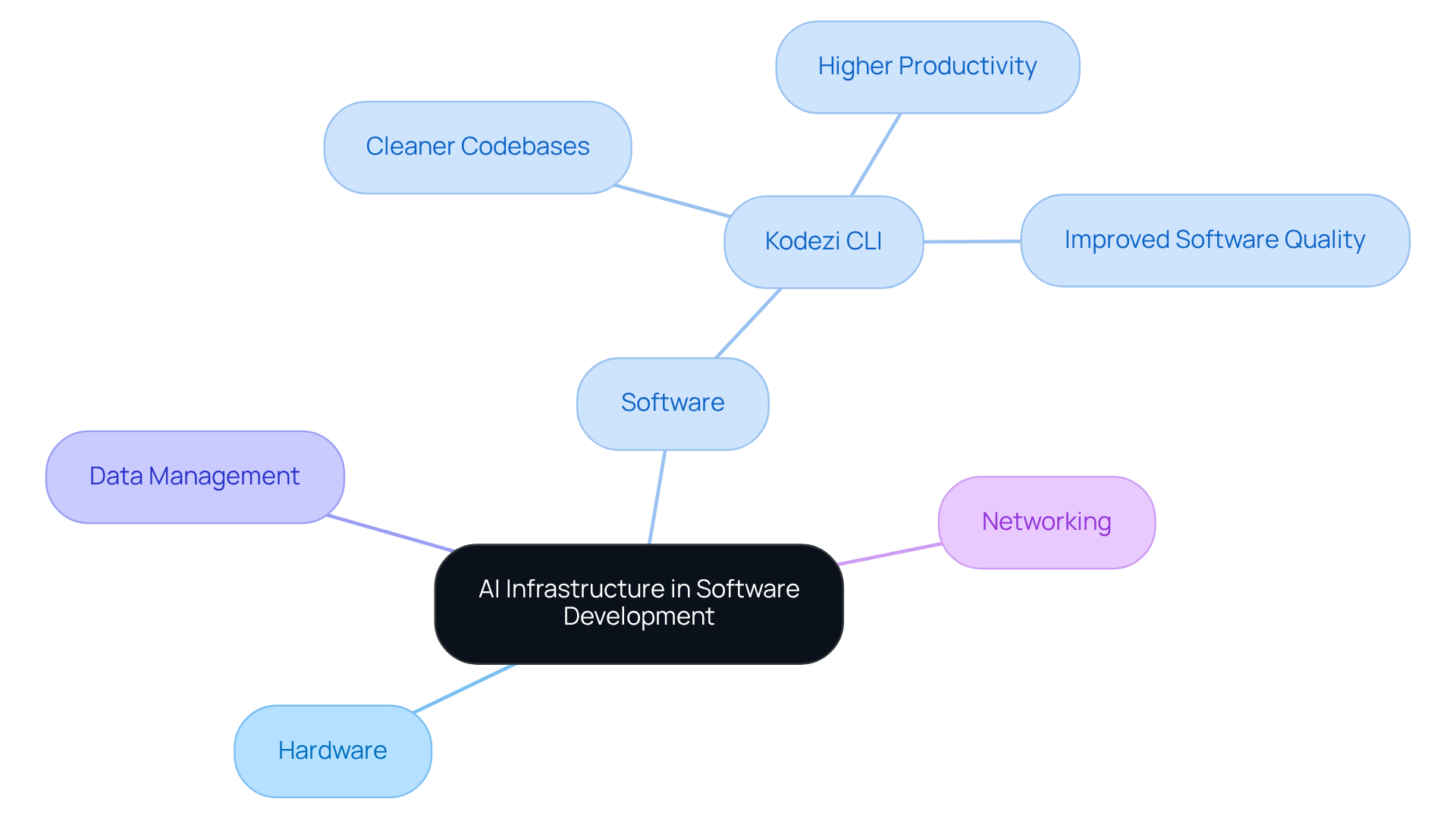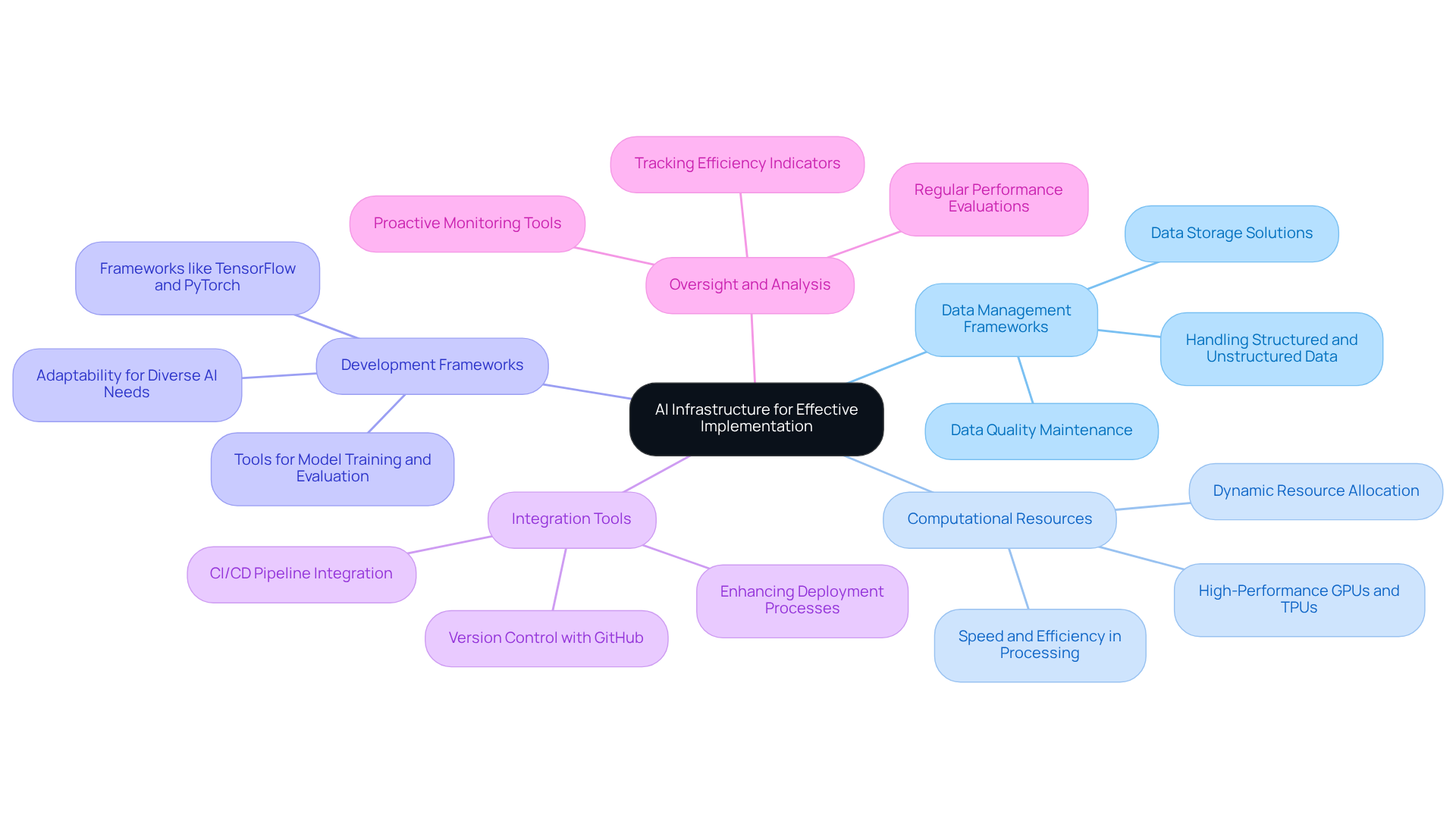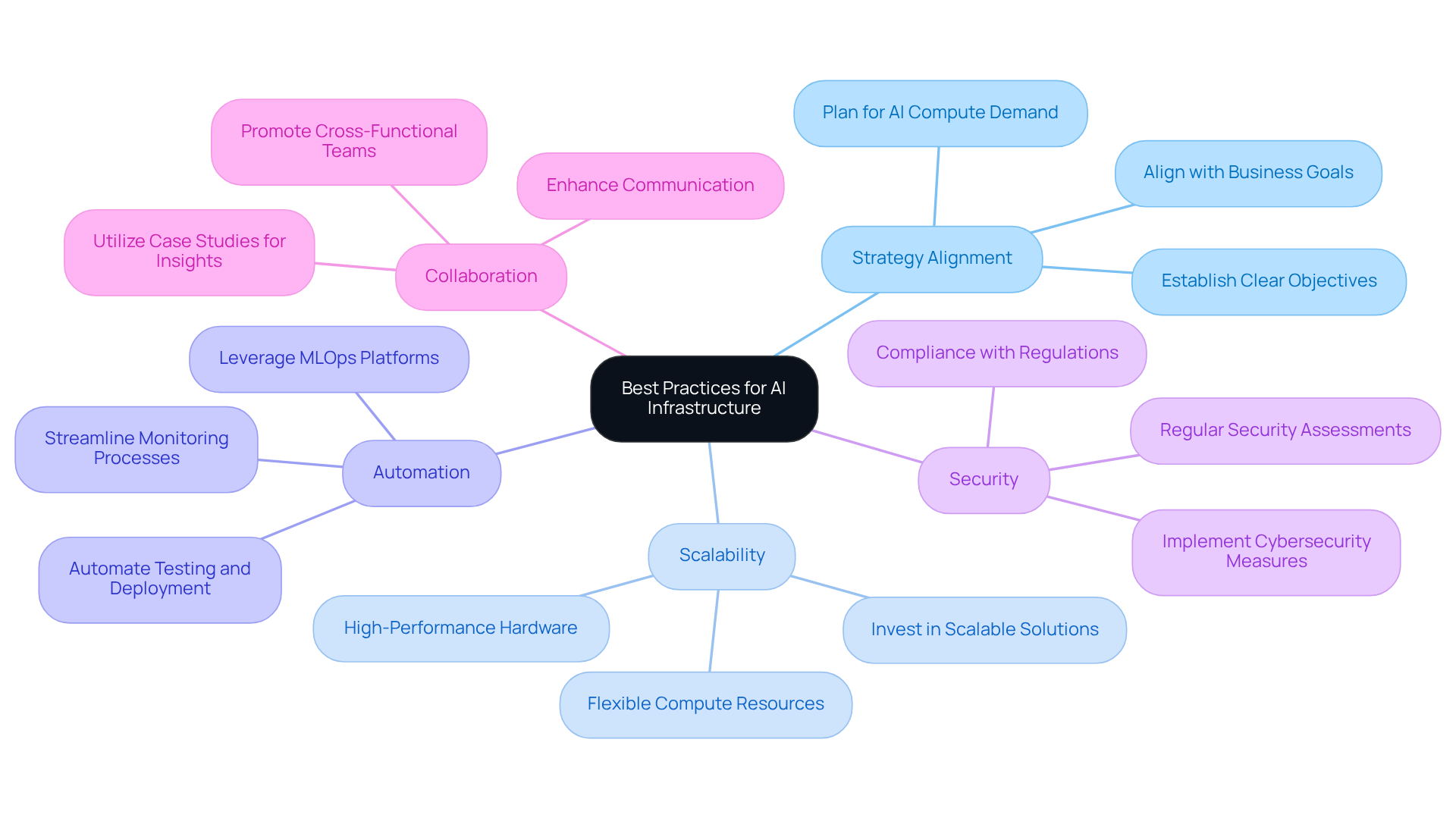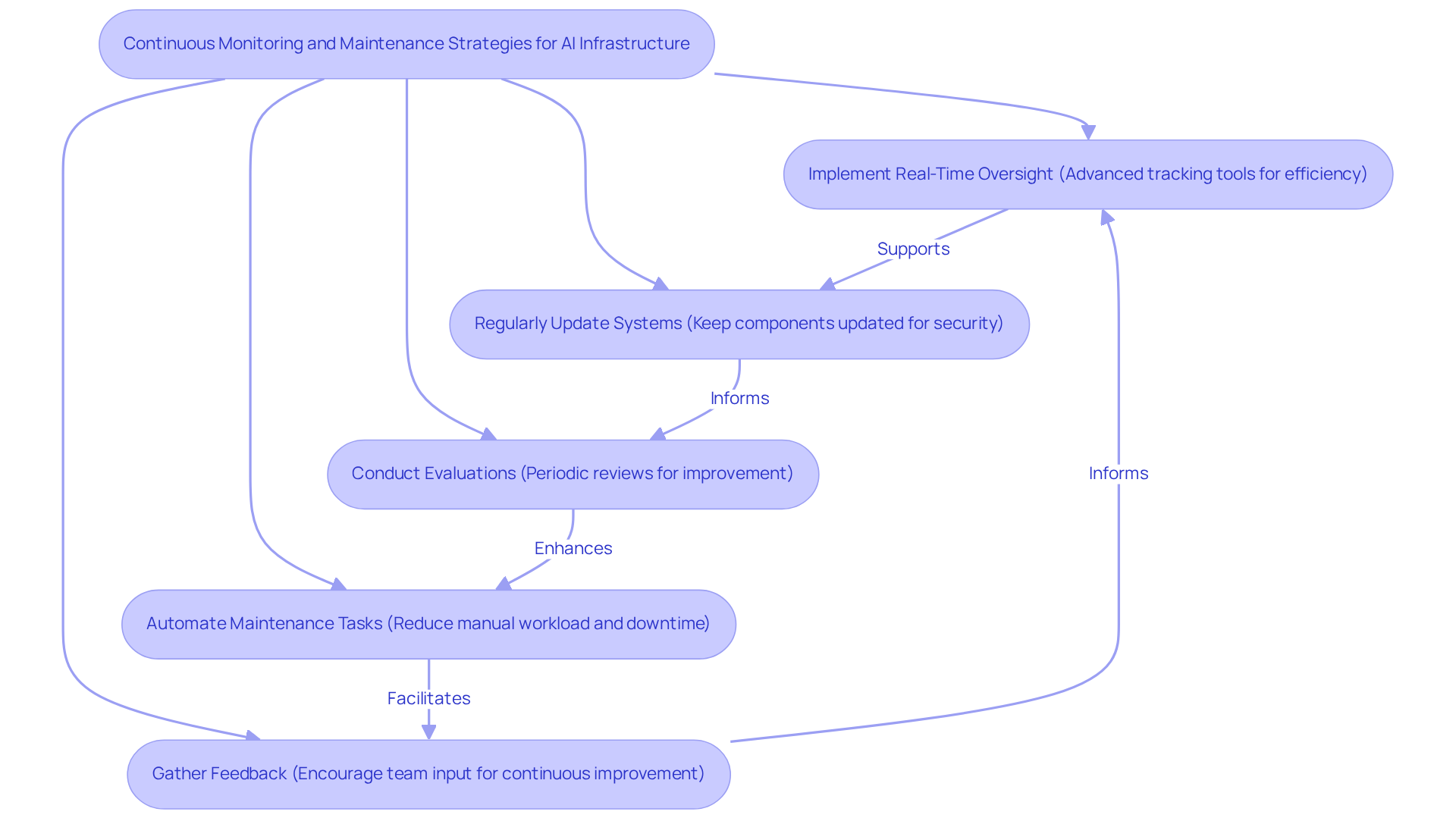Overview
In the realm of software development, coding challenges are a common hurdle that many developers face. How can these challenges be effectively addressed? Mastering AI infrastructure can significantly enhance software development efficiency, and tools like Kodezi CLI offer innovative solutions. Kodezi's features, such as code quality improvement, robust data management frameworks, and automation strategies, are designed to tackle these issues head-on.
By leveraging Kodezi, developers can reduce manual errors and accelerate deployment processes. This not only leads to cleaner codebases but also boosts overall productivity in software development. Have you considered how much time could be saved by optimizing your coding practices? The benefits of using Kodezi extend beyond mere efficiency; they encompass a comprehensive approach to elevating code quality.
Furthermore, Kodezi empowers developers to focus on what truly matters—creating exceptional software. The integration of AI tools means that mundane tasks are automated, allowing for a more streamlined workflow. In addition, the platform provides valuable insights that help refine coding practices, ensuring that developers can produce high-quality work consistently.
As you explore the tools available on Kodezi, think about the potential improvements in your coding routine. With Kodezi, you can transform your development process into one that is not only more efficient but also more enjoyable. Why not take the first step towards enhancing your software development efficiency today?
Introduction
In the rapidly evolving landscape of software development, developers face significant coding challenges that can hinder productivity. The integration of artificial intelligence is not merely a trend; it has become a necessity. Kodezi addresses these challenges by offering a robust AI infrastructure that enhances coding practices, streamlines processes, and ultimately leads to superior software quality.
How can teams leverage Kodezi to overcome these obstacles and boost productivity? This article explores essential components, best practices, and strategies for optimizing AI infrastructure. By implementing Kodezi, teams can transform their development experience and pave the way for innovative solutions.
Define AI Infrastructure and Its Importance in Software Development
In the realm of software development, coding challenges can often hinder progress. How can developers navigate these complexities effectively? The AI infrastructure for software development plays a crucial role in addressing these issues. They provide the foundational systems and technologies necessary for deploying and managing artificial intelligence applications. This includes an array of components—hardware, software, data management, and networking—that work in unison to enhance AI functionalities.
One standout tool in this landscape is Kodezi CLI. This innovative solution autonomously improves code quality by identifying and fixing bugs before they reach production. By leveraging AI infrastructure for software development within the development lifecycle, teams can significantly reduce manual errors and accelerate testing and deployment processes. Furthermore, Kodezi ensures adherence to security best practices and coding standards, which is vital in today’s fast-paced development environment.
The benefits of utilizing Kodezi are clear: cleaner codebases, higher productivity, and improved software quality. Imagine a world where your team spends less time troubleshooting and more time innovating. Wouldn’t that be a game changer? By leveraging Kodezi, developers can transform their coding practices, leading to not only enhanced efficiency but also a more robust final product.
Explore the tools available on the Kodezi platform and discover how they can elevate your development experience. Embrace the future of coding with AI infrastructure for software development that empowers you to achieve your goals more effectively.

Identify Key Components of AI Infrastructure for Effective Implementation
To effectively implement AI infrastructure, several key components must be considered.
-
Data Management Frameworks: Effective data storage and retrieval mechanisms are essential for training AI models. This includes databases and data lakes capable of handling large volumes of structured and unstructured data, ensuring integrity and accessibility. According to industry insights, robust data management solutions are essential for maintaining data quality, which directly impacts the performance of AI models.
-
Computational Resources: High-performance computing resources, such as GPUs and TPUs, are vital for processing complex algorithms and large datasets. These specialized hardware components significantly enhance speed and efficiency in AI tasks, enabling organizations to manage intricate computations effectively. For instance, organizations leveraging high-performance GPUs can achieve faster processing times, which is critical for training large-scale AI models.
-
Development Frameworks: Employing frameworks such as TensorFlow or PyTorch simplifies the creation of AI models, enabling smoother incorporation into current structures. These frameworks provide essential tools and libraries for constructing, training, and evaluating AI models, ensuring adaptability for diverse AI needs. Expert opinions emphasize that proficiency in these frameworks is vital for unlocking the full potential of AI capabilities.
-
Integration Tools: Tools that enable smooth integration with CI/CD pipelines and version control platforms, such as GitHub, are essential for upholding code quality and deployment efficiency. These integrations facilitate ongoing observation and enhancement, which are vital for maintaining efficiency and security in AI operations. Case studies have shown that effective integration tools can significantly enhance deployment processes and reduce errors.
-
Oversight and Analysis: Utilizing tracking tools to measure efficiency indicators and network wellbeing guarantees that the AI framework stays effective and capable over time. Ongoing observation allows for early detection of issues and regular performance evaluations, enabling proactive adjustments that enhance overall system resilience and responsiveness. As emphasized in recent studies, organizations that prioritize monitoring tools can better manage their AI systems, leading to enhanced operational efficiency.

Implement Best Practices for Building and Optimizing AI Infrastructure
Building and optimizing the AI infrastructure for software development is a complex task that demands adherence to several best practices. Have you considered how a well-defined strategy can set the foundation for your AI initiatives? Establishing clear objectives that align with overarching business goals is essential. This alignment not only supports your vision but also maximizes impact. For example, organizations should note that AI compute demand is projected to increase by as much as 100 times as enterprises deploy AI agents, making strategic planning critical.
What if you could invest in scalable solutions that grow with your needs? Choosing technologies designed for scalability allows your framework to expand without significant renovations. This foresight is crucial, as organizations may need to invest millions to tens of millions of dollars for full-stack AI digital products or AI-as-a-factory service models.
How can automation transform your processes? Leveraging automation tools for testing, deployment, and monitoring minimizes manual intervention, enhances efficiency, and enables teams to focus on innovation rather than routine tasks. For instance, MLOps platforms can streamline the deployment and management of AI models, significantly reducing operational overhead.
Are your systems secure and compliant? Regularly assessing your systems for vulnerabilities and ensuring adherence to industry regulations such as GDPR and HIPAA is vital. Implementing robust cybersecurity measures protects sensitive data and maintains trust, as non-compliance can lead to severe penalties. Routine security evaluations and vulnerability analyses help recognize and manage possible risks in AI systems.
How important is collaboration in your organization? Promoting cross-functional collaboration among development, operations, and data science teams enhances communication and teamwork, leading to more efficient project execution. Case studies show that organizations prioritizing collaboration see improved outcomes in their AI projects, as diverse perspectives contribute to innovative solutions. For instance, the case study on 'Continuous Oversight and Optimization of AI Infrastructure' illustrates how proactive supervision improves system resilience and prevents failures.
By incorporating these best practices, organizations can build a robust AI framework that not only meets current needs but is also prepared for future challenges.

Establish Continuous Monitoring and Maintenance Strategies for AI Infrastructure
To ensure the longevity and effectiveness of your AI infrastructure, it is essential to establish continuous monitoring and maintenance strategies that can significantly enhance operational performance.
-
Implement Real-Time Oversight: Have you considered how advanced tracking tools can transform your operational efficiency? By utilizing these tools, you can assess resource usage and identify potential bottlenecks in real time. This proactive approach enables immediate issue detection, thereby enhancing operational efficiency. According to Gartner, continuous monitoring is crucial for maintaining performance and security in AI technologies.
-
Regularly Update Systems: Are your systems up to date? Keeping all components of your infrastructure updated is vital. Regular updates not only leverage the latest features but also ensure that security patches are applied, significantly reducing vulnerabilities. Statistics indicate that obsolete frameworks are more prone to breaches, underscoring the significance of prompt updates.
-
Conduct Evaluations: How often do you review your metrics? Periodically evaluating your systems is essential for identifying areas for improvement. This practice allows teams to enhance resource distribution and boost overall system efficiency, ensuring that the framework meets evolving requirements. A case study on the ongoing monitoring and enhancement of AI systems demonstrated substantial advancements in operational efficiency through regular evaluations.
-
Automate Maintenance Tasks: Are you still performing maintenance tasks manually? Automating routine tasks, such as backups and updates, minimizes downtime and reduces the manual workload on your team. This efficiency enables engineers to focus on innovation rather than repetitive tasks. Mirantis highlights that automation in AI system management can lead to decreased operational complexity and enhanced resource utilization.
-
Gather Feedback: How valuable is your team's input? Encouraging team members to provide feedback on the system's performance and usability is invaluable for continuous improvement. This engagement can lead to innovative solutions and better alignment with operational goals.
By implementing these strategies, organizations can maintain a robust AI infrastructure that supports ongoing development and operational excellence.

Conclusion
Mastering AI infrastructure is essential for addressing the coding challenges developers encounter. The integration of advanced tools and best practices allows developers to navigate these obstacles effectively, streamline their processes, and ultimately enhance the quality of their software. Solutions like Kodezi CLI exemplify the transformative potential of AI infrastructure, empowering teams to shift their focus from troubleshooting to innovation, thus fostering a more productive development environment.
Key components such as:
- Data management frameworks
- Computational resources
- Integration tools
play a crucial role in establishing a robust AI infrastructure. Each element not only contributes to the operational efficiency of AI applications but also enhances the overall quality and security of the software developed. Furthermore, adhering to best practices—including:
- Strategic planning
- Automation
- Continuous monitoring
ensures that AI systems remain effective and adaptable to evolving needs.
As organizations look to the future, embracing these insights and strategies will be vital. The landscape of software development is rapidly changing; those who prioritize AI infrastructure will be better positioned to thrive. Investing in scalable solutions and fostering collaboration among teams can lead to significant advancements in project outcomes. By taking proactive steps now, organizations can harness the full potential of AI, ensuring their software development processes are not just efficient but also innovative and future-ready.
Frequently Asked Questions
What is AI infrastructure in software development?
AI infrastructure in software development refers to the foundational systems and technologies necessary for deploying and managing artificial intelligence applications. It includes components such as hardware, software, data management, and networking that work together to enhance AI functionalities.
Why is AI infrastructure important in software development?
AI infrastructure is important because it helps developers navigate coding challenges, reduces manual errors, and accelerates testing and deployment processes. It ensures adherence to security best practices and coding standards, which are vital in today's fast-paced development environment.
What is Kodezi CLI and how does it relate to AI infrastructure?
Kodezi CLI is a tool that autonomously improves code quality by identifying and fixing bugs before they reach production. It leverages AI infrastructure to enhance the development lifecycle, making it easier for teams to manage code quality and efficiency.
What are the benefits of using Kodezi?
The benefits of using Kodezi include cleaner codebases, higher productivity, and improved software quality. It allows teams to spend less time troubleshooting and more time innovating, leading to a more robust final product.
How can developers explore tools available on the Kodezi platform?
Developers can explore the tools available on the Kodezi platform by visiting the Kodezi website or platform, where they can discover various tools designed to elevate their development experience and enhance coding practices.




